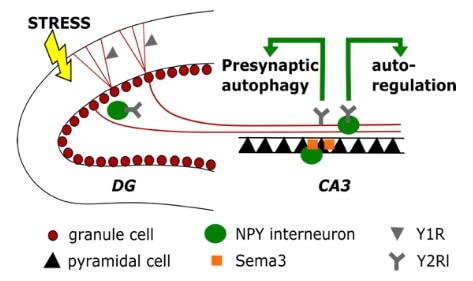NPY-mediated autophagy and the adaptation of hippocampal circuits to stress
ANNE ALBRECHT (Otto-von-Guericke University, Magdeburg)
OLIVER STORK (Otto-von-Guericke University, Magdeburg)


The mammalian brain has an enormous capacity for structural and functional plasticity adjusting behavior to an ever-changing environment. This ability requires highly coordinated signaling, synchronized (de-)construction of synapses and adjustment of proteostasis in functional neuronal circuits. Maladaptive changes, arising from early-life adverse experiences, traumatic stress or neurodegenerative processes, can lead to neuropsychiatric conditions such as post-traumatic stress disorder (PTSD), depression or dementia.
Neuropeptide Y (NPY) is well established as an anxiolytic and stress-reducing factor and NPY transmission in the dorsal dentate gyrus (DG) has been demonstrated by us and others to control fear memory salience and traumatic stress resilience. Moreover, recent evidence suggests that NPY might play a key role in synaptic preoteostasis, by regulating neuronal autophagy both in vertebrates and invertebrates and that this might explain its capacity to modulate long-term cellular changes in neural circuitry. In this project we will therefore study the role of NPY-induced autophagy in a local circuit relevant for stress adaptation and emotional and cognitive information processing.
Specifically, in the DG-to-cornu ammonis (CA)3 system we will address mechanisms of behavioral induced autophagy in DG mossy fibers (MF) and their associated local NPY-secreting interneurons. The role of postsynaptic NPY-Y1 and pre-synaptic/autoregulatory NPY-Y2 receptors as well as intracellular and local circuitry signals will be examined. In addition, we will investigate the behavioral consequences of disturbed NPY-induced autophagy in these cells and ultimately aim to identify molecular and cellular processes that mediate NPY-induced adaptive changes and stress resilience. Our project intends to bridge a cellular and molecular analysis of autophagy to its involvement in adaptive cognitive and emotional brain function and is thereby interwoven with various other research projects of Syntophagy.

Mossy fiber / NPY circuitry in the DG-CA3. DG granule cells and their mossy fibers provide excitatory input to CA3 pyramidal cells as well as to NPY expressing interneurons, which in turn exert local inhibition. We postulate an activation of autophagy through NPY in these divergent synaptic connections upon stress, leading to long-term autoregulation of interneurons and adjustment of MF structure and function.
References:
Ivens, S., … Stork, O., Albrecht, A. (2019) Persistent increase in ventral hippocampal long-term potentiation by juvenile stress: A role for astrocytic glutamine synthetase. Glia 67:2279-2293.
Saha, R., … Albrecht, A. (2018) Neurofascin Knock Down in the Basolateral Amygdala Mediates Resilience of Memory and Plasticity in the Dorsal Dentate Gyrus Under Stress. Mol Neurobiol 55:7317-7326.
Raza, S.A.*, Albrecht, A.*… Stork, O. (2017) HIPP neurons in the dentate gyrus mediate the cholinergic modulation of background context memory salience. Nat Commun 8:189.
Albrecht, A. … Stork, O., Richter-Levin, G. (2017) Neurobiological consequences of juvenile stress: A GABAergic perspective on risk and resilience. Neurosci Biobehav Rev 74:21-43.
Albrecht, A.*, Ivens, S.*… Stork, O. (2016) Shifts in Excitatory/Inhibitory Balance by Juvenile Stress: A Role for Neuron–Astrocyte Interaction in the Dentate Gyrus. Glia 64:911-922.
Regev-Tsur S, … , Stork O, … Albrecht A (2020). Region-specific involvement of interneuron subpopulations in trauma-related pathology and resilience. Neurobiol Dis. 143:104974
Albrecht A, Ben-Yishay E, Richter-Levin G (2021). Behavioral profiling reveals an enhancement of dentate gyrus paired pulse inhibition in a rat model of PTSD. Mol Cell Neurosci. 2021 111:103601.
Madencioglu DA, …,Kreutz MR, Stork O. (2021) Transgenic modeling of Ndr2 gene amplification reveals disturbance of hippocampus circuitry and function. iScience 24(8):102868.